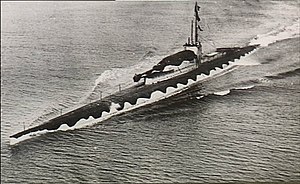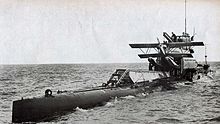Submarine class M (Royal Navy)
| M-class |
||
|---|---|---|
 M1 while driving |
||
| General data | ||
| Ship type : | Submarine ( u-cruiser ) | |
| Navy : | Royal Navy | |
| Builders : | ||
| Units: | 4 (3 completed) | |
| Boats of the class | ||
| M1 , M2 , M3 | ||
| Technical data before conversion |
||
| Crew : | 64 men | |
| Displacement : |
|
|
| Length : | 90.15 m | |
| Width: | 6.20 m | |
| Drive : |
|
|
| Speed : | ||
| Driving range : |
|
|
| Diving depth : | 60 m | |
| Arming before conversion |
||
| Torpedo tubes : |
|
|
| Artillery : | ||
The M-Class was a class of U-cruisers in the British Royal Navy . The submarine monitors had by far the heaviest artillery armament in the entire history of submarine construction.
Building history
In 1915 the British government ordered 21 units of the Vickers designed very fast steam turbine powered K-class . In addition to the concept of fast fleet boats, the chief of the British submarine weapon, Commodore Hall, called for heavily armed submarine monitors. The heavy artillery of the gunboats was to be used both in trade disturbance warfare and in bombardment of enemy coastal fortifications.
In February 1916, four U-cruisers armed with heavy artillery were ordered instead of the construction contracts K18 to K21 . The M-Class was not a conversion of the K-Class construction projects that had been started, but the result of the modification of the construction contracts for only planned units. Technically, the M-Class is not based on the K-Class, but is an independent construction.
Four units were laid down in 1916. The M1 entered service in April 1918, but no longer played a significant role in World War I. The M2 and M3 entered service in 1920. The M4 , launched in 1919 after the end of the war, was no longer finished.
Constructive features
Performance data
The two-hulled boats had a classic hybrid drive consisting of two 12-cylinder Vickers diesel engines , each with an output of 1200 PS (900 kW ) and two electric motors of 800 PS (600 kW). The maximum diving depth stated as safe was 60 m. When surfaced, the submarines could travel up to 4500 nautical miles (8300 km) at a speed of 10 knots (19 km / h ) . Under water the range at two knots (approx. 4 km / h) speed was 80 nautical miles (148 km).
Armament
The submarines were armed with four 18- inch (457-mm) torpedo tubes in the bow and a 3-inch (76.2-mm) anti-aircraft cannon.
The main armament consisted of an oversized gun in 12 inches (305 mm) caliber. The boats could carry up to 50 rounds of heavy ammunition. At that time, torpedoes were still very unreliable and inferior to heavy artillery within range.
The MK type guns . IX came from the 1915 sunk battleship HMS Formidable , from whose wreck they had been recovered. The gun structure in front of the command tower had a lateral swivel range of 15 ° and an elevation range of −10 ° to + 20 °. A clearly visible front sight was attached to the gun barrel so that the periscope could also be aimed. The weapon could also be fired half submerged. However, to reload it had to be completely surfaced. Due to the small swivel range, the entire boat had to be aimed. This is why a lot of time passed between the detection of a target and the first shot. However, due to surfacing during the reloading process, it took a longer time until the second shot, so that only a low cadence was possible. In addition, a surfaced submarine is an easy target to destroy in a naval battle. Other tasks, such as bombarding enemy coastal positions, were able to perform surface ships more efficiently. There was also a constructive problem. The huge guns were intended for use on large battleships. The dimensions of the barette required a very large opening in the pressure hull, which impaired its stability. A water ingress in the gun body inevitably meant the loss of the entire submarine. The concept of super-heavy artillery on submarines ultimately failed.
Conversions

Since the Washington Fleet Conference limited the maximum caliber of submarine artillery to 8 inches (203 mm), the gun superstructures of the remaining units were later removed.
The M2 instead received a flameproof aircraft hangar and was as aircraft carrier used. The Parnall Peto seaplane was specially developed for this purpose .
The M3 was converted into a mine-layer. An additional mine deck was set up on the upper deck. The mines were transported with a chain construction to a rear gate, from where they were relocated. It could transport and lay up to a hundred sea mines . The M3 proved itself in this role. The tried and tested installation system was later also used by the Porpoise class (also known as the Grampus class ).
Mission history
The M1 entered service on April 17th of the last year of the war. The very next day the new building in the Irish Sea discovered a large German submarine that had surfaced. In the time it took to prepare and align the main gun, the enemy dived and escaped. In June 1918 the M1 was relocated to the Mediterranean . She was to take part in a planned sea-based artillery attack against Constantinople . The operation was not carried out.
From 1920 all three boats were ready for use. They were primarily used as test vehicles. The M1 sank two decommissioned submarines during artillery exercises. The M2 conducted several experimental deep dives in 1923 and participated in a sea-based poison gas attack that same year . During one dive, the submarine lost its trim and dived 73 m deep, but was then able to surface again.
In 1924 the three submarines were given different paints. M1 was painted gray-green, M2 dark gray and M3 dark blue. The aim of the experiment was to optimize the camouflage paintwork of submarines against enemy aerial reconnaissance.
On November 12, 1925, the M1 was lost off Plymouth . During a sea exercise, the submerged submarine was rammed by the Swedish coal steamer Vidar . The M1 sank with the entire crew. The wreck was discovered in 1969 at a depth of 73 m.
As a result of international disarmament treaties, the main guns of the two remaining boats were removed between 1925 and 1928.
During the nationwide general strike between May 9 and 15, 1926, the M3 was used as a local power station for two London naval yards.
The M2 converted to a seaplane carrier sank in 1932 west of the island of Portland with the entire crew under unexplained circumstances. Presumably the hangar was not properly closed after the aircraft was deployed . The wreck lies in 32 m depth is still more British than target practice Sonar - Gasten used.
The M3 was sold for scrapping in 1932.
Boats of the class
Three boats were built. The fourth planned submarine was not completed.
| boat | Shipyard | Keel laying | Launch | Commissioning | comment |
|---|---|---|---|---|---|
| HMS M1 | Vickers | July 1, 1916 | July 9, 1917 | April 17, 1918 | Sunk after a collision in 1925 |
| HMS M2 | Vickers | July 13, 1916 | October 19, 1918 | February 14, 1920 | 1925 conversion to aircraft mother ship; Sunk in 1932 |
| HMS M3 | Armstrong Whitworth | 4th December 1916 | October 19, 1918 | July 9, 1920 | 1928 conversion to minelayer; Scrapped in 1932 |
| HMS M4 | Armstrong Whitworth | December 1, 1916 | July 20, 1919 | Construction canceled |
See also
- Submarine class M (other submarine classes of the same name)
literature
- Robert Hutchinson: Fight Under Water. Submarines from 1776 to the present day. Motorbuch-Verlag, Stuttgart 2006, ISBN 3-613-02585-X
- Anthony Preston: The History of the Submarines. Karl Müller, Erlangen 1998, ISBN 3-86070-697-7
Web links
- K-Class at www.battleships-cruisers.co.uk (English)
- K- and M-Class (English)
- U-boat database at www.submariners.co.uk (English)
- Text on the sunken submarines (English)
